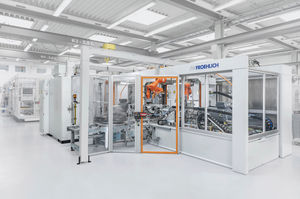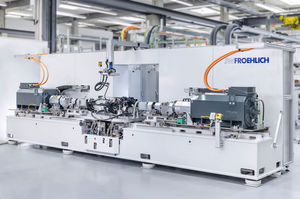
- Detection - Measurement
- Flow, Pressure and Level Measurements
- Automatic leak tester
- JW FROEHLICH Maschinenbau GmbH
Gas device function test leak test bench automatic



Add to favorites
Compare this product
Characteristics
- Applications
- for gas device function test
- Other characteristics
- automatic
Description
Permanent leak tightness (IP67) is a key prerequisite of batteries used in e-mobility. Testing must produce safe and reliable results to avoid short circuits due to splashing. Helium leak testing has a major advantage over air leak testing: It is able to detect even very small leaks (ca. 2.5 cm³ at 50 mbar). There is very little helium in the ambient air, enabling reliable test results even when only slightly increased concentrations of the gas can be detected.
The helium sniffing test uses a sniffer probe to scan all possible leakage points of a test part filled with helium, enabling it to particularly reliably and accurately detect and later repair possible faults. The concentration of the helium/gas mixture can vary depending on the task at hand, making it possible to use it cost-efficiently. JW Froehlich has decades of experience in this field.
A German OEM required test stands which are able to safely test large quantities of components in very little time to start serial production of truck batteries. Their requirement was maximum product and process safety at optimum cost efficiency. A solution for tailor-made and automated test stands for two different locations was developed in close collaboration with the client, and delivered within eight months. Based on these developments, another 20 helium leak test stands were ordered at a later date. Further lines will be equipped by the end of 2024, bringing the total number of helium leak test stands to 30.
Test methods and contents
Test procedure
Inserting the battery into the helium leak test station
Positioning of test part
Closing roller shutters
Contacting and sealing the battery (manually or automatically,
Catalogs
No catalogs are available for this product.
See all of JW FROEHLICH Maschinenbau GmbH‘s catalogsOther JW FROEHLICH Maschinenbau GmbH products
Electric drive
Related Searches
- Calibration system
- JW FROEHLICH leak tester
- Pressure leak testing device
- Pressure calibration system
- JW FROEHLICH automatic leak tester
- Packaging leak testing device
- Process calibration system
- Vessel leak testing device
- USB leak testing device
- JW FROEHLICH leak tester for automotive applications
- Compact leak tester
- Valve leak testing device
- Flow leak testing device
- Color display leak testing device
- Leak tester with programmable logic controller (PLC)
- Leak tester for aeronautical applications
- Leak calibrator
- Profibus leak testing device
- LAN leak testing device
- Mass flow leak testing device
*Prices are pre-tax. They exclude delivery charges and customs duties and do not include additional charges for installation or activation options. Prices are indicative only and may vary by country, with changes to the cost of raw materials and exchange rates.







